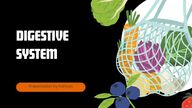
Return to flip book view
DIGESTIVESYSTEMPresentation by Kahaan
INTRODUCTIONThe digestive system, which includesthe mouth, oesophagus, stomach,small intestine, large intestine, rectum,and anus, as well as the liver,pancreas, and gallbladder, is anessential component of the humanbody that breaks down food intonutrients the body can use.
MouthThe mouth is the beginning of thedigestive system. It is where youchew your food into smaller piecesand mix it with saliva. Saliva containsenzymes that start to break downcarbohydrates and fats in your food.The tongue helps to move the foodaround and push it to the back of themouth for swallowing.
PharynxThe pharynx is a muscular tubethat connects the mouth to theesophagus. It is also part of therespiratory system, as it allowsair to pass from the nose to thelungs. The pharynx has a flap oftissue called the epiglottis thatcloses over the entrance to thetrachea (windpipe) when youswallow, preventing food fromentering the airway.
EsophagusThe esophagus is a long, musculartube that carries food from thepharynx to the stomach. It usesrhythmic contractions calledperistalsis to move the food along.The lower esophageal sphincter(LES) is a ring of muscle at the endof the esophagus that relaxes tolet food enter the stomach andcontracts to prevent stomach acidfrom flowing back into theesophagus.
Stomach The stomach is a sac-like organ thatstores and churns the food you eat. Itsecretes gastric juice, which containshydrochloric acid and digestiveenzymes that break down proteinsand fats. The stomach also producesa mucus layer that protects its liningfrom the acid. The stomach can holdabout 1.5 liters of food and liquid.The pyloric sphincter is a ring ofmuscle at the end of the stomach thatcontrols the passage of food into thesmall intestine.
Small intestine The small intestine is a long, coiled tube thatextends from the stomach to the large intestine. Itis divided into three sections: the duodenum, thejejunum and the ileum. The small intestine iswhere most of the digestion and absorption ofnutrients takes place. The small intestine receivesbile from the liver and gallbladder, andpancreatic juice from the pancreas, which help todigest fats, carbohydrates and proteins. The smallintestine has millions of tiny finger-like projectionscalled villi that increase its surface area and allownutrients to be absorbed into the bloodstream.
Large intestineThe large intestine is a wider and shorter tube thatconnects the small intestine to the anus. It is alsoknown as the colon. The large intestine absorbswater and electrolytes from the undigested foodand forms solid waste, or feces. The largeintestine has four sections: the ascending colon,the transverse colon, the descending colon andthe sigmoid colon. The large intestine alsocontains beneficial bacteria that help to breakdown some of the remaining food and producevitamins. The rectum is the final part of the largeintestine that stores feces until they are ready tobe expelled. The anus is the opening at the end ofthe digestive tract that allows feces to exit thebody.
LiverThe liver is a large organ that liesunder the right rib cage. It has manyfunctions, such as producing bile,storing glycogen, detoxifying drugsand alcohol, synthesizing proteinsand hormones, and regulating bloodsugar and cholesterol levels. Bile is agreenish-yellow fluid that helps toemulsify fats and make them easier todigest. Bile is stored in thegallbladder, a small sac that liesunder the liver, and released into theduodenum when needed.
PancreasThe pancreas is a gland that liesbehind the stomach. It producespancreatic juice, which containsdigestive enzymes that help to breakdown fats, carbohydrates andproteins. Pancreatic juice is deliveredto the duodenum through thepancreatic duct. The pancreas alsoproduces hormones, such as insulinand glucagon, that regulate bloodsugar levels.